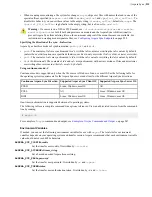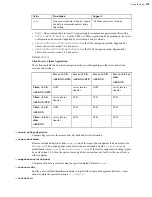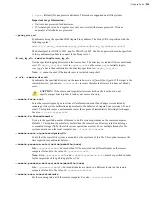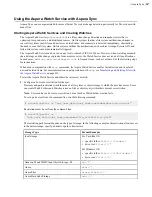
| Aspera Sync |
247
Examples of Async Commands and Output
Examples of common Aspera Sync use cases and a description of
async
output.
Async Command Examples
1. Continuous synchronization of a daily archive of large files on a Windows computer to Linux computer,
preserving Windows ACLs, run as an
async
pull on the Linux computer:
$ async -L /sync/logs -N backup -d /sync/backup -r
[email protected]:"C:\data\" -i /.ssh/lion_private_key
-K pull --remote-scan-interval=4h --preserve-acls=metafile --remote-
preserve-acles=metafile -C --exclude-dirs-older-than=1w0d0h0m0s
Details:
• Logs are stored on the Linux computer in the specified location.
• The user, lion, authenticates with an SSH key using the
-i
option
• Because the files in the backup are large,
remote-scan-interval
is used to scan the Windows computer
every 4 hours, which forces an additional scan in case any notifications are missed.
• In order to preserve Windows ACLs in the backup, both
preserve-acls=metafile
and
remote-
preserve-acls=metafile
must be specified.
• Since the archive directory creates a new directory for each day, use
exclude-dirs-older-
than=1w0d0h0m0s
to avoid scanning directories that are no longer changing (older than a week).
2. High performance push synchronization of many (10,000s) of small files (<10 KB) between Windows
computers:
> async -L c:/logs:200 -q -N small-files -c none --pending-max=10000 --
preserve-acls=native --transfer-threads=4 -R c:/logs:200 -d c:/data/ -r
[email protected]:"C:\data\" -K push -l 500m
Details:
• Specifying the logging locations (
-L
and
-R
) is optional. Adding
:200
to the end of the log directory value
allows the logs to reach 200 MB before being rotated.
• If the connection is secure, disabling encryption using
-c none
may boost performance.
• Increase the number of pending files from the default of 2000 using
--pending-max=10000
.
• The
--preserve-acls=native
option preserves Windows ACLs.
• Using more FASP threads to move the data can improve performance, set with
--transfer-threads=4
.
The number of threads should not exceed the number of CPU cores (the lower value of the client and server
computers).
• The user must enter the password at the prompt because it is not provided in the command. Aspera
recommends using SSH keys for authentication, but this is not required.
3. Non-continuous bidirectional synchronization of directories containing a mix of large and small files in
which small files are synchronized using one thread and large files use another, run on a Linux computer to
a macOS computer:
$ async -L /sync/logs -q -N sync-2017-01-01 -d /images --
[email protected] --host=10.4.25.10 -r Library/data/images
-i /lion/.ssh/lion_private_key -R Library/sync/logs --transfer-
threads=2:100000 -K bidi
Details:
• Logs are saved in the specified locations on both computers.
• The user authenticates with an SSH key using the
-i
option.
• The user and host are specified as separate options, rather than as part of the destination folder, so that the
username with an @ can be used (@ is reserved in an
-r
argument for specifying the host).
















































